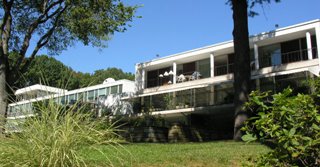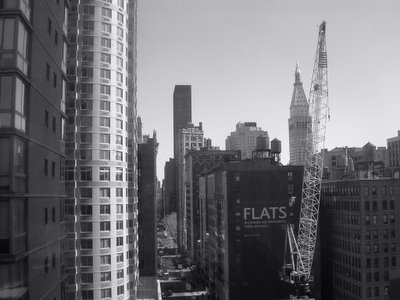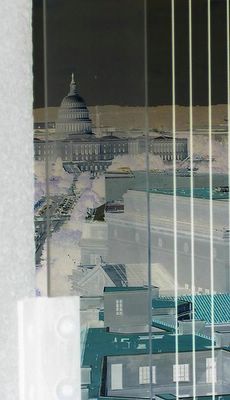ANN ARBOR: Maynard Street's Living Tomb
 IF THIS PHOTO SEEMS A BIT GRAINY, it's because it's a photo I took of a paper print out of a photo taken by then-Michigan Daily photographer David Katz (who, last time I checked, was working for Illinois Sen. Barack Obama). The real photo is framed and sits in the Library of the Student Publications Building, which is shown in this photo. Who's in the photo, you ask? University of Michigan graduate Mike Wallace of CBS' "60 Minutes" and then-Michigan Daily editorial page editor Michael Grass (that's me, the one who's oddly figiting with his thumbs) in the background. (Wallace is reading the Daily's editorial page, by the way.)
IF THIS PHOTO SEEMS A BIT GRAINY, it's because it's a photo I took of a paper print out of a photo taken by then-Michigan Daily photographer David Katz (who, last time I checked, was working for Illinois Sen. Barack Obama). The real photo is framed and sits in the Library of the Student Publications Building, which is shown in this photo. Who's in the photo, you ask? University of Michigan graduate Mike Wallace of CBS' "60 Minutes" and then-Michigan Daily editorial page editor Michael Grass (that's me, the one who's oddly figiting with his thumbs) in the background. (Wallace is reading the Daily's editorial page, by the way.) I'VE WRITTEN QUITE A BIT about architectural legacy in recent weeks (from the Heurich House to my recent visit to the new Balducci's in the old New York Savings Bank building), so any Michigan Daily alum who may be reading this probably knows what direction I'm about to go: the upcoming funerary celebration for The Michigan Daily's legendary home: 420 Maynard St.
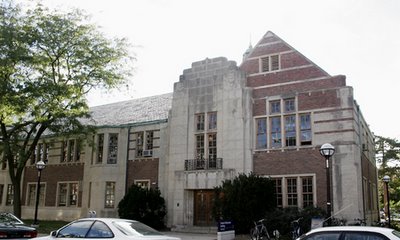 AT THE END OF THE CURRENT SCHOOL TERM, 420 Maynard St. will be closed off for the first major renovations since the place was built in the early 1930s. Countless journalists got their start in the media business inside the walls of the beautiful Collegiate Gothic/Art Deco building. If you were Tom Hayden behind the City Desk in the grand vaulted News Room, you were working pretty much in the same environment that Arthur Miller did when the late acclaimed playwright was on staff in the 1930s. If you were Josh White, an editor in chief in the late 1990s, you were likely to work at some of the same desks that Robin Wright worked at when she was covering Bo Schembechler and the Wolverine football team. (From my understanding, White and Wright, now top reporters at The Washington Post, sit at adjacent desks down at 15th and L streets NW.) Read Wright's Michigan-football-as-diplomacy article from the Aug. 31, 2005 issue of the Post, here. It's great, even if you're not a fan of Ann Arbor.
AT THE END OF THE CURRENT SCHOOL TERM, 420 Maynard St. will be closed off for the first major renovations since the place was built in the early 1930s. Countless journalists got their start in the media business inside the walls of the beautiful Collegiate Gothic/Art Deco building. If you were Tom Hayden behind the City Desk in the grand vaulted News Room, you were working pretty much in the same environment that Arthur Miller did when the late acclaimed playwright was on staff in the 1930s. If you were Josh White, an editor in chief in the late 1990s, you were likely to work at some of the same desks that Robin Wright worked at when she was covering Bo Schembechler and the Wolverine football team. (From my understanding, White and Wright, now top reporters at The Washington Post, sit at adjacent desks down at 15th and L streets NW.) Read Wright's Michigan-football-as-diplomacy article from the Aug. 31, 2005 issue of the Post, here. It's great, even if you're not a fan of Ann Arbor.420 Maynard St. hasn't had a thorough cleaning in years. Dust from the late 1970s was sacred, journalistic pixie dust of generations past that would carry young reporters up the Daily's masthead and, hopefully, to success in the big leagues of the newspaper world. When I was there, it was possible to find ancient critique sheets in file drawers of the two long countertops that divided the editorial and business staffs. There were no formal filing systems. There was a stolen Michigan State University police barricade above the Sports desk. In the Library (as you can see in the top photo), there was an old Daily photo of the late-Sen. Eugene McCarthy that somehow survived the 1970s, '80s and '90s to stand next to a photo of then-Michigan Gov. John Engler and then-University of Michigan President Lee Bollinger, who is now the top dog at Columbia University. Next to that were the aging bound volumes, deteriorating because of their position next to drafty windows and the oily fingers of Daily staffers (like yours truly) who ate up the history inside their pages. (The Dec. 7, 1941, "WAR!" newspaper has been viciously ripped to shreds, but fortunately, there is a second set of papers at the Bentley Historical Library.)
 The stresses of the building could be seen in other places. A past Student Publications Building manager had constructed an elaborate rainwater trough system that collected water that ran down the interior walls of his office during downpours. Ivy started to grow inside the News Room. Window sills were cracked. For three years of my time on Maynard Street, there was an odd plastic bladder of a white cleaning fluid sitting near the back door, without much of a purpose. 420 Maynard St. was a building that didn't like to be clean.
The stresses of the building could be seen in other places. A past Student Publications Building manager had constructed an elaborate rainwater trough system that collected water that ran down the interior walls of his office during downpours. Ivy started to grow inside the News Room. Window sills were cracked. For three years of my time on Maynard Street, there was an odd plastic bladder of a white cleaning fluid sitting near the back door, without much of a purpose. 420 Maynard St. was a building that didn't like to be clean.During a Board of Regents meeting when I was a Daily administration reporter, Robert Kasdin, then Bollinger's executive vice president, gave a brief presentation on the Student Publication Building's numerous "life safety" issues. There was a great slide show of the Daily's house of disarray: Our server room, with numerous odd wiring configurations, had fire hazard written all over it. There were water leaks. A green chair had been tossed into an ancient urinal in the musty-but-beautifully tiled downstairs bathroom. And to top it off, the lack of egress from the building was a problem too. After the front doors were locked at 5 p.m., the only way in and the only way out was trough the back door, which was connected directly to the front entry area. The Washtenaw County fire marshal for sure frowned on that. The regents turned over to the press gallery, eyeing me. I shrugged my shoulders. Bollinger chuckled.
The Michigan Daily likes to think of itself as independent from the university administration for obvious editorial principles. Renovations had been planned since the administration of James Duderstadt (perhaps earlier), but the Daily wasn't going to take university funds to renovate the place. The Daily, after all, had built the Student Publications Building, also home to the Michiganensian yearbook and the Gargoyle humor magazine, which were stashed away in closet-like rooms on the ground floor. But the money was indeed raised from private donors after years in the works.
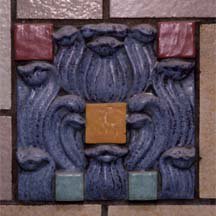 DESPITE THE CONSTANT THREAT OF DEATH inside the building, the Daily flourished. It has turned out great journalists for generations (and it will continue to, for sure). But there are those irreplaceable collective memories, of course, the good and the bad. While the renovated building will be for sure great (and give the Daily's new journalists the facility they need in the new media world), it will lack so many of the charming qualities 420 Maynard St. has had since the Great Depression. There is a big Daily reunion planned for April, just before the building is mothballed. And part of the building sacred to all Daily alums -- the Attic -- will be closed off forever.
DESPITE THE CONSTANT THREAT OF DEATH inside the building, the Daily flourished. It has turned out great journalists for generations (and it will continue to, for sure). But there are those irreplaceable collective memories, of course, the good and the bad. While the renovated building will be for sure great (and give the Daily's new journalists the facility they need in the new media world), it will lack so many of the charming qualities 420 Maynard St. has had since the Great Depression. There is a big Daily reunion planned for April, just before the building is mothballed. And part of the building sacred to all Daily alums -- the Attic -- will be closed off forever. From a forwarded e-mail I received recently:
The attic will be not accessible after the renovation, due to the fact that it really doesn't meet code for anyone other than maintenance type people to be there. Also the attic will be fitted with a fire suppression system (think sprinklers) which we don't want damaged. Consequently, we are thinking that former edit staff members may wish to go to attic and retrieve the items that are there and determine what they would want to do with them. No plan has been finally determined, but I am certainly aware of the significance that the attic and the items in the attic have for many alumni.For those unfamiliar, the Attic is where outgoing Daily seniors go on their last night of putting out the paper and leave things for the next generation of Daily staffers to find when it was their turn. When I went up there, there was some alcohol and other meaningful souvenirs waiting for me (and others), as were there notes left from past senior editors when I was a freshman and sophomore. There has always been a "Don't Talk About the Attic" mentality as to not ruin the surprise for the underclassmen. But since the place will be cleaned out of its contents and closed to future Daily staffers, it now seems OK to talk about the Attic.
You entered through an odd little utility closet via a ladder and a trap door in the ceiling. Then you were in the Attic's dark crawlspace. There was one lightbulb that gave scant illumination of the gangplanks and various other ladders that went to various parts of the Attic, above the structural ribbing and plaster above the various rooms of the second floor, including the grand vaults of the News Room. There was one gangplank that hung above the very top of the News Room's vaults and went to the building's southern brick wall. It was on that wall where I signed my name, with some of my closest comrades in arms at the time. I'm glad my mark on the building will have a little more permanence, even if it is inaccessible for future generations.
 But yet, the Attic is a very dangerous place. If you fell off the gangplank and through the plaster, you were likely to crash into the Cathedral of Journalism below and die in its Nave, likely on top of some random printer circa 1995 still hanging around for no apparent reason. The editor in chief had a more dangerous mission: the changing of the turret's light bulb. Climbing further up into the Attic, the EIC had to navigate an awkward set of ladders -- high above the plaster ceiling, which was high above the two-story staircase hall -- and put in a new light bulb, which typically changed color from year to year and was never turned off. It would eventually burn out in a few months, just as the current class of editors were probably getting sick of each other and was getting ready to recruit (or thwart) underclassmen who had eyes on their elders' positions. So to boil it all down, it's nostalgia central.
But yet, the Attic is a very dangerous place. If you fell off the gangplank and through the plaster, you were likely to crash into the Cathedral of Journalism below and die in its Nave, likely on top of some random printer circa 1995 still hanging around for no apparent reason. The editor in chief had a more dangerous mission: the changing of the turret's light bulb. Climbing further up into the Attic, the EIC had to navigate an awkward set of ladders -- high above the plaster ceiling, which was high above the two-story staircase hall -- and put in a new light bulb, which typically changed color from year to year and was never turned off. It would eventually burn out in a few months, just as the current class of editors were probably getting sick of each other and was getting ready to recruit (or thwart) underclassmen who had eyes on their elders' positions. So to boil it all down, it's nostalgia central.WHAT ELSE IS BEING LOST?
- The Bat Cave: When some of the News Room's space was reconfigured in the 1970s (I think), a secret room was created that could only be accessed through what looked like cabinet doors. When I was a News reporter and editor, we held our 4:15 p.m. story conferences there. It was a place where we would forward phone calls for more private telephone interviews. (I will always remember as a freshmen, an elder News editor saying to Mike Wallace over the phone: "Mr. Wallace, I'm going to patch you through to the Bat Cave.") It's where we hid from Falun Gong protesters. It was the room where we fired reporters. It's where editors yelled at each other in private. It was also during my junior and senior years where I would pull all-nighters, lining the room's molding with Red Bull so I could catch up on archaeology reading or write a paper on Soviet foreign policy. (The Arts room was good for that, too.)
The Bat Cave will be eliminated, but if I'm looking at floor plans correctly, will be recreated elsewhere.
- The Back Staircase: Tucked behind the City Desk, below a giant window with leaded-glass panes, is the staircase that countless Dailyites over the generations walked up and down, sometimes many times during a production night, between the News Room and the Production Room, which was once home to a giant printing press. The stairs were so worn by years of feet, the Back Staircase, much like the Front Staircase, took on characteristics similar to the Propylea before Athens' Acropolis: a grand portal, worn by generations of walking.
The Back Staircase -- including its intricate grillwork -- will be eliminated and relocated. We can only hope that the replacement staircase doesn't end up like countless other staircases across the University of Michigan campus: ugly, closeted, punctuated by utility piping, all tied together by a white plaster theme.
IT IS DOUBTFUL that I will be returning to Ann Arbor before the building and all the memories are ripped out and retooled for the next generation. Let me make it clear: I do think it is necessary that the building gets renovated. But the University of Michigan's track record in historic preservation has been mixed at best. The Board of Regents seems to care little for the architectural history of Ann Arbor, unless there is a tangible alumni concern attached to it. For example, we lost E. Ann Street's beautiful Planada Apartments to the expanding Medical Campus, which also claimed much of the area near Wall Street and Lower Town -- which was home to some of Ann Arbor's oldest homes from the 1830s (and nationally significant Greek Revival architecture) and was also Robert Frost's home turf in the 1920s. Much of the area has been paved over by parking lots.
Although it would be nice to see my old Daily colleagues in April, I'm not big on funerals. I'd rather be surprised upon my return in a few years to see a beautiful new building. I just hope that the Board for Student Publications builds a better building, re-creating in the newer parts of the building the current interior architectural themes that make 420 Maynard St. special. If not, then we are dealing with a big loss.
For background on the renovations, visit the Board for Student Publications' Renovations page.
OK, enough memories and architectural legacies. I've gone on for way too long.
Photos of 420 Maynard Street from the Board for Student Publications.

